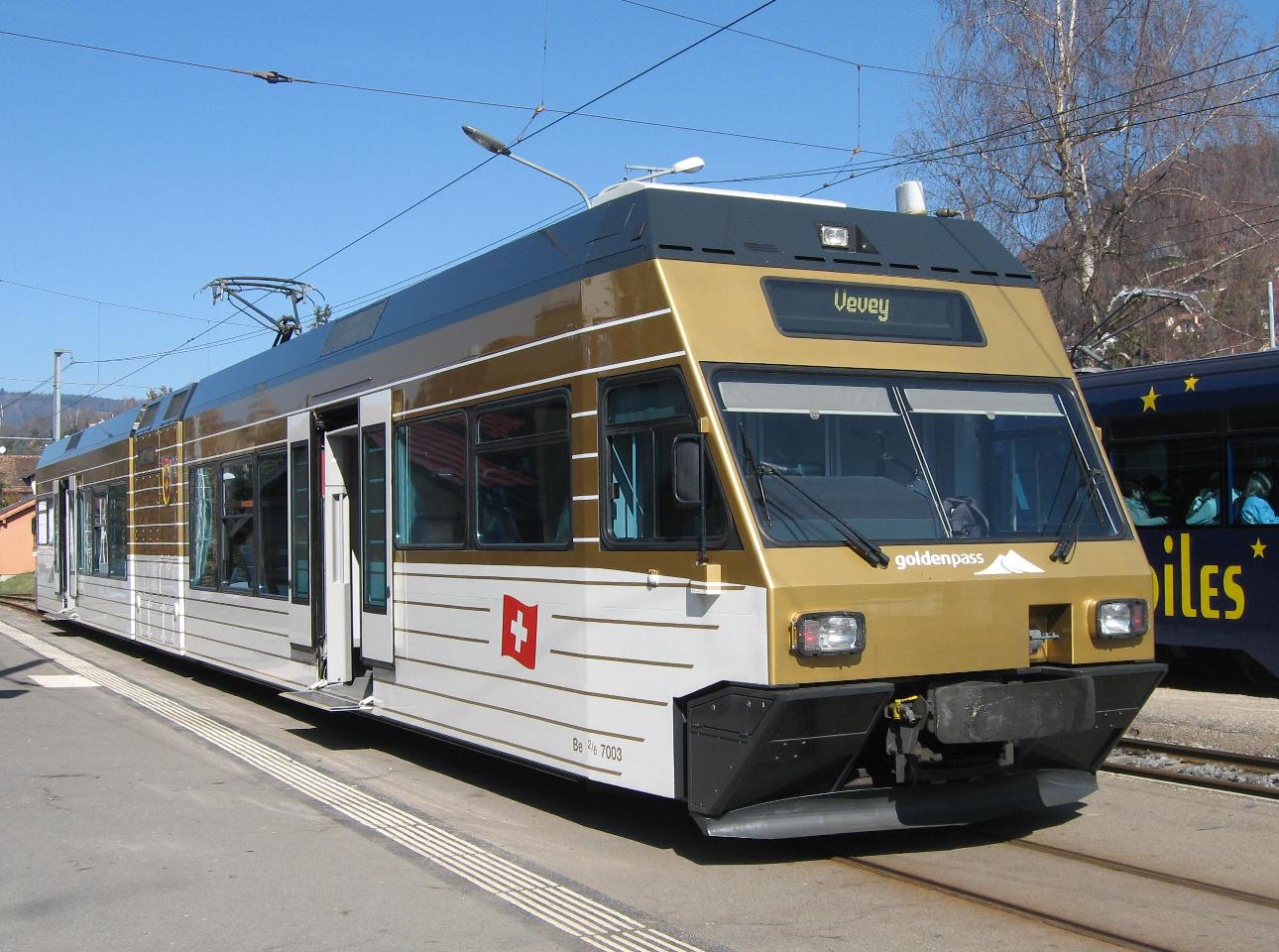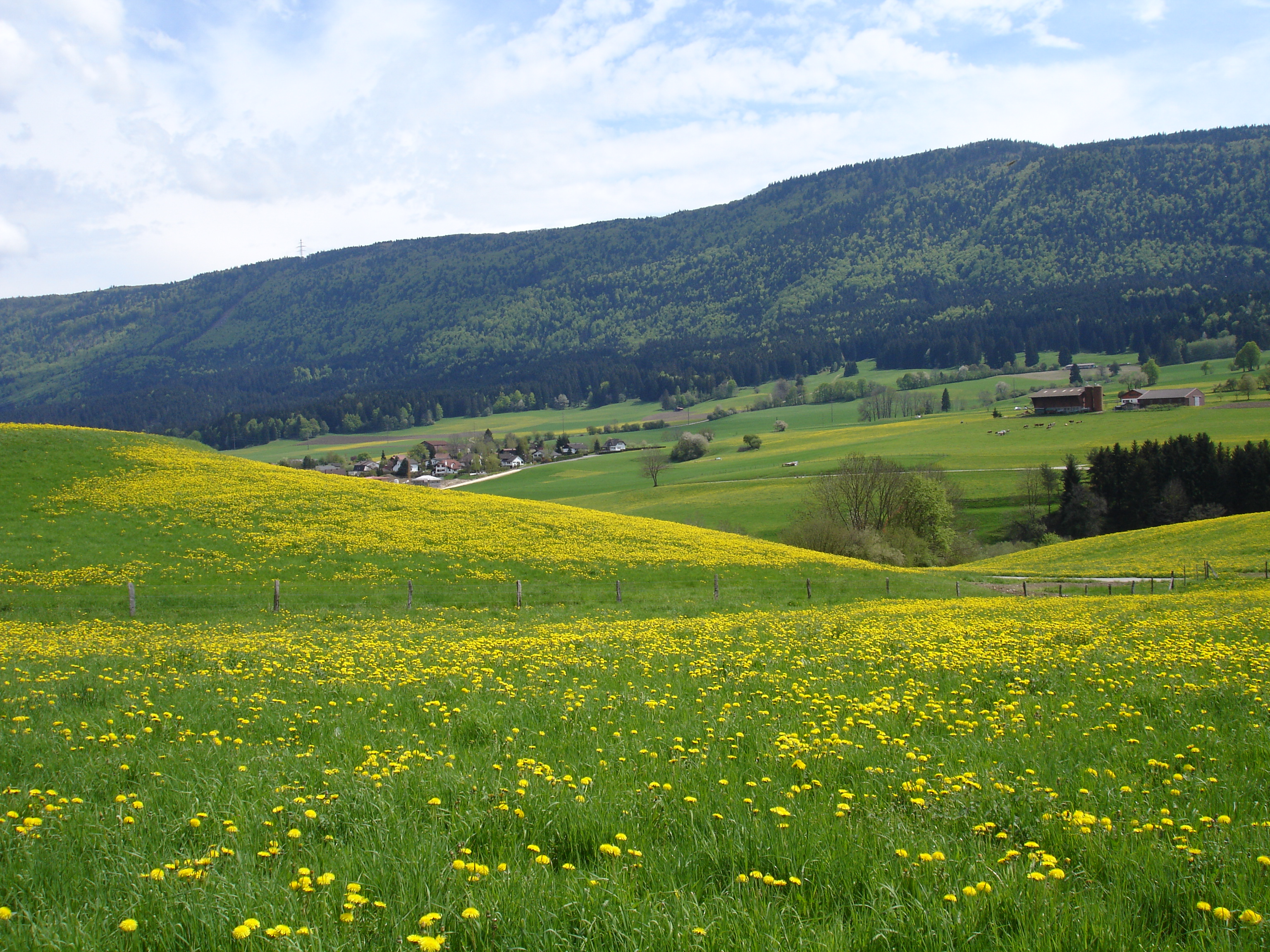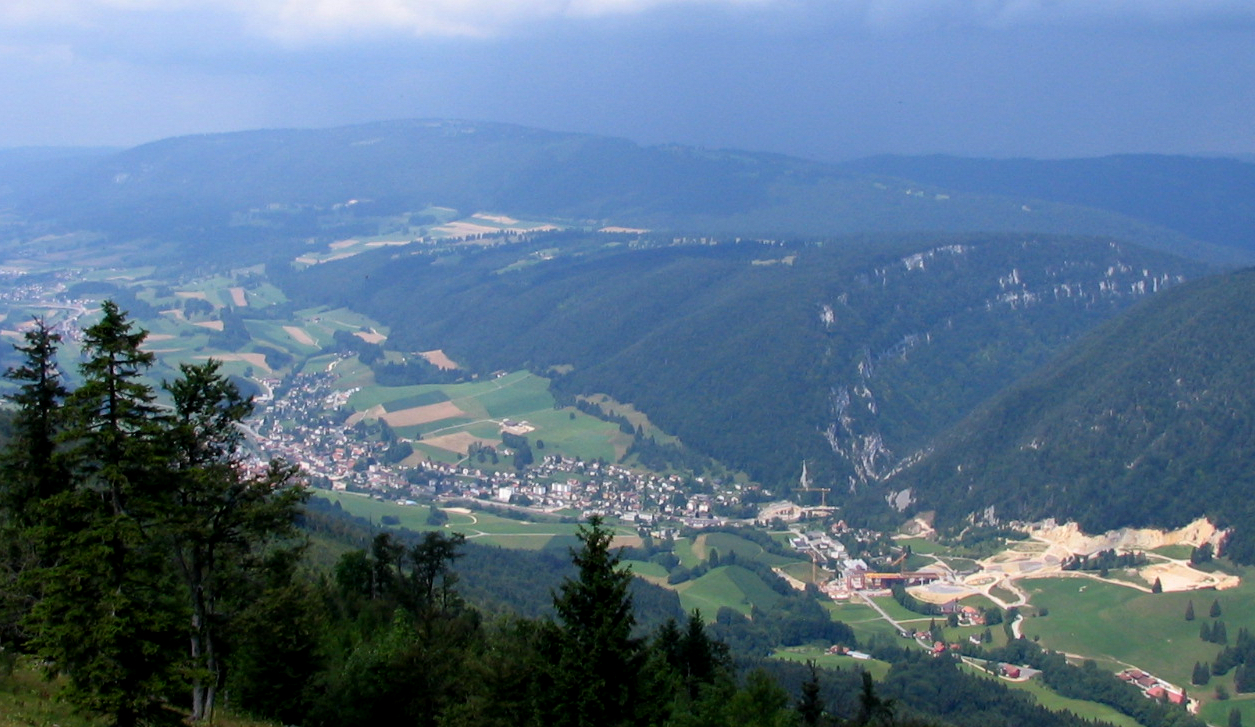|
Sonceboz-Sombeval–Moutier Railway
The Sonceboz-Sombeval–Moutier railway is a single-track standard gauge railway line of the Swiss Federal Railways (SBB). History The line from Biel/Bienne via Sonceboz-Sombeval to Moutier was built by the Jura bernois (JB) and was part of the international connection from Bern to Delémont and on to Belfort via Delle or Basel. The Biel/Bienne–Sonceboz-Sombeval–Tavannes section was opened along with the Sonceboz-Sombeval–Convers(–La Chaux-de-Fonds) line on 30 April 1874. Two years later, on 16 December 1876, the Tavannes–Court section was opened together with the Moutier–Delémont railway. The intermediate Court–Moutier section followed on 24 May 1877. The Jura bernois changed its name to Jura–Bern–Luzern (JBL) in 1884. The JBL merged with the Western Switzerland–Simplon Company (''Compagnie de la Suisse Occidentale et du Simplon'', SOS) on 1 January 1890 to form the Jura–Simplon Railway (''Compagnie des Chemins de Fer Jura–Simplon'', JS). The J ... [...More Info...] [...Related Items...] OR: [Wikipedia] [Google] [Baidu] |
Stadler GTW
The Stadler GTW is an articulated railcar for local transport made by Stadler Rail of Switzerland. GTW stands for Gelenktriebwagen (articulated railcar). History The Biel–Täuffelen–Ins-Bahn near Bern, Switzerland was looking for a lighter train model to replace its aging fleet, so that a low floor system does not require heavy installations on the roof. Based on that requirement Stadler came up with a concept of placing most of the equipment in a central unit between the seating cars. While the BTI-Bahn tracks are meter gauge, Stadler presented the first prototype in 1995 set on standard gauge rails, and the Mittelthurgau-Bahn tested three prototypes on its standard gauge network during 1996. The rolling stock for Mittelthurgau was later expanded to 10 GTW 2/6 (built 1998–1999) that are now part of the THURBO fleet (the three prototypes were sold to Italy). The next lots were produced in meter gauge, and were delivered to the BTI-Bahn and the CEV-Bahn (Chemins de fer éle ... [...More Info...] [...Related Items...] OR: [Wikipedia] [Google] [Baidu] |
Belfort
Belfort (; archaic german: Beffert/Beffort) is a city in the Bourgogne-Franche-Comté region in Northeastern France, situated between Lyon and Strasbourg, approximately from the France–Switzerland border. It is the prefecture of the Territoire de Belfort department. Belfort is from Paris, from Strasbourg, from Lyon and from Zürich. The residents of the city are called "Belfortains". The city is located on the river Savoureuse, on a strategically important natural route between the Rhine and the Rhône – the Belfort Gap (''Trouée de Belfort'') or Burgundian Gate (''Porte de Bourgogne''). It is located approximately south from the base of the Ballon d'Alsace mountain range, source of the Savoureuse. The city of Belfort has 46,443 inhabitants (2019).Télécha ... [...More Info...] [...Related Items...] OR: [Wikipedia] [Google] [Baidu] |
Bévilard
Bévilard is a municipality in the Jura bernois administrative district in the canton of Bern in Switzerland. It is located in the French-speaking Bernese Jura (''Jura Bernois''). On 1 January 2015 the former municipalities of Bévilard, Malleray and Pontenet merged to form the new municipality of Valbirse.Amtliches Gemeindeverzeichnis der Schweiz published by the Swiss Federal Statistical Office accessed 2 January 2013 History Bévilard is first mentioned in 1182 as ''Bevilar''. In German it was known as ''Bewiler'' though this is not used currently. Very little is known about the early history of the village. During the 13th and 14th centuries the noble Bévilard family appear in a few records. Throughout much of its ...[...More Info...] [...Related Items...] OR: [Wikipedia] [Google] [Baidu] |
Malleray
Malleray is a municipality in the Jura bernois administrative district in the canton of Bern in Switzerland. It is located in the French-speaking Bernese Jura (''Jura Bernois''). On 1 January 2015 the former municipalities of Bévilard, Malleray and Pontenet merged to form the new municipality of Valbirse.Amtliches Gemeindeverzeichnis der Schweiz published by the Swiss Federal Statistical Office accessed 2 January 2013 History Malleray is first mentioned in 1179 as ''Malareia''. The municipality was formerly known by its German name ''Mallaraya'', however, that name is no longer used. Very little is known about the early history of the village. In 1367, the |
Reconvilier
Reconvilier is a municipality in the Jura bernois administrative district in the canton of Bern in Switzerland. It is located in the French-speaking Bernese Jura (''Jura Bernois''). History Reconvilier is first mentioned in 884 as ''Roconis villare''. The former German name Rokwiler is no longer used today. The oldest trace of a settlement in the area are two ceramic and three bronze bowls which probably come from a Roman villa from the 2nd or 3rd century. In 884, the village appears as an estate belonging to Moutier-Grandval Abbey. The noble Reconvilier family appears in historical records beginning in the 12th century and lasting until the 15th. The village remained under the Abbey's control until it was secularized around 1531. Then Reconvilier came under the authority of the provost of Moutier-Grandval who represented the Prince-Bishop of Basel. After the 1797 French victory and the Treaty of Campo Formio, Reconvilier became part of the French Département of Mont- ... [...More Info...] [...Related Items...] OR: [Wikipedia] [Google] [Baidu] |
Birs (river)
The Birs (French: ''Birse'') is a long river in Switzerland that flows through the Jura region and ends as a tributary to the Rhine between Basel and Birsfelden. It is the most important river of the Swiss Jura. Course The Birs has its source in a spring near the ''Col de Pierre Pertuis'' at above sea level a little southwest of Tavannes in the ''Jura bernois''. It starts as a proper river; the large amount of water is the product of an extended underground river system. The Birs runs through wider valleys (Vallée de Tavannes) and narrow gorges. Near Delémont, the capital of the canton of Jura, it joins the Sorne and the Scheulte. Between Soyhières and Liesberg, it leaves the French-speaking part of Switzerland, enters the canton of Basel-Landschaft and receives the Lützel from the left. In Laufen it forms a waterfall, which was the source of power and of the name of the city. At the gorge of Angenstein, the river runs into the ''Birseck'', the lowland by Aesch. Bet ... [...More Info...] [...Related Items...] OR: [Wikipedia] [Google] [Baidu] |
Metre-gauge Railway
Metre-gauge railways are narrow-gauge railways with track gauge of or 1 metre. The metre gauge is used in around of tracks around the world. It was used by European colonial powers, such as the French, British and German Empires. In Europe, large metre-gauge networks remain in use in Switzerland, Spain and many European towns with urban trams, but most metre-gauge local railways in France, Germany and Belgium closed down in the mid-20th century, although many still remain. With the revival of urban rail transport, metre-gauge light metros were established in some cities, and in other cities, metre gauge was replaced by standard gauge. The slightly-wider gauge is used in Sofia. Examples of metre-gauge See also * Italian metre gauge * Narrow-gauge railways A narrow-gauge railway (narrow-gauge railroad in the US) is a railway with a track gauge narrower than standard . Most narrow-gauge railways are between and . Since narrow-gauge railways are usually built with ... [...More Info...] [...Related Items...] OR: [Wikipedia] [Google] [Baidu] |
Grenchen
Grenchen (french: Granges) is a municipality in the district of Lebern in the canton of Solothurn in Switzerland. It is located at the foot of the Jura mountains between Solothurn and Biel/Bienne, approximately north of Bern. With over 16,000 inhabitants, it is one of the larger towns of the canton of Solothurn. The city is well known for its watch industry, that has been present for more than 150 years. Grenchen is the 2008 winner of the Wakker Prize for architectural heritage. Jura-Sternwarte Grenchen is located at Grenchen. History Around 1000 AD, the local barons built a castle on the local cliff that was inhabited for three centuries. The name Grenchen was first documented in 1131 as ''Granechun''. The name comes from the gallo-romanic ''graneca'', meaning ''by the granary''. * 1851: Clock manufacture begins * 1918: General strike Geography Grenchen has an area, , of . Of this area, or 37.9% is used for agricultural purposes, while or 40.1% is forested. Of the r ... [...More Info...] [...Related Items...] OR: [Wikipedia] [Google] [Baidu] |
Grenchenberg Tunnel
The Grenchenberg (1,405 m) is a mountain of the Jura, located on the border between the Swiss cantons of Bern and Solothurn. The mountain is named after the town of Grenchen Grenchen (french: Granges) is a municipality in the district of Lebern in the canton of Solothurn in Switzerland. It is located at the foot of the Jura mountains between Solothurn and Biel/Bienne, approximately north of Bern. With over 16,000 i ..., located on its south side. References External linksGrenchenberg on Hikr Mountains of the Jura Mountains of Switzerland Mountains of the canton of Bern Mountains of the canton of Solothurn One-thousanders of Switzerland Bern–Solothurn border {{Solothurn-geo-stub ... [...More Info...] [...Related Items...] OR: [Wikipedia] [Google] [Baidu] |
Western Switzerland–Simplon Company
The Western Switzerland Railways (''Chemins de fer de la Suisse Occidentale'', shortened to ''Suisse-Occidentale''; SO or S-O), were initially a joint operation of three Swiss railway companies, but these companies merged on 1 January 1872. The company was called the Western Switzerland–Simplon Railways (''Chemins de fer de la Suisse Occidentale et du Simplon'', shortened to ''Suisse-Occidentale–Simplon''; SOS or SO-S) from 28 June 1881. The SOS merged with the Bernese Jura Railways (''Chemins de fer du Jura bernois''; JBL) to form the Jura–Simplon Railways (''Compagnie des Chemins de Fer Jura–Simplon''; JS) on 1 January 1890. Association of the Railways of Western Switzerland In the early 1860s, the rail links between Romandy and German-speaking Switzerland were controlled by three railway companies, the West Switzerland Company (''Compagnie de l’Ouest Suisse''; SO), the Franco-Swiss Company (''Franco-Suisse'', FS) and the Lausanne–Fribourg–Bern Railway (''Chemi ... [...More Info...] [...Related Items...] OR: [Wikipedia] [Google] [Baidu] |
Court, Switzerland
Court is a municipality in the Jura bernois administrative district in the canton of Bern in Switzerland. It is located in the French-speaking Bernese Jura (''Jura Bernois''). History Court is first mentioned in 1148 as ''Cort''. Between the 12th and 15th centuries the village of Mévilier or Minvilier existed between Court and Champoz. During the 15th Mévilier village was abandoned for an unknown reason. For most of its history, Court was part of the district of Orval which was owned by the provost of Moutier-Grandval Abbey. After the 1797 French victory and the Treaty of Campo Formio, Court became part of the French Département of Mont-Terrible. Three years later, in 1800 it became part of the Département of Haut-Rhin. After Napoleon's defeat and the Congress of Vienna, Court was assigned to the Canton of Bern in 1815. Originally, Court was part of the parish of Mévilier. By the 16th century it was part of the parish of Sorvilier. In 1531, Court adopted the new ... [...More Info...] [...Related Items...] OR: [Wikipedia] [Google] [Baidu] |







